#la salpetriere
Explore tagged Tumblr posts
Text
La Salpêtriére in Les Misérables
No better time than today (June 5th, Barricade Day) to discuss something of personal interest to me, as well as relevant to this blog.
In the time of Les Misérables, La Salpêtriére was not the hub of neurological study and research we see in the second half of the 19th century, of which this blog focuses on, but instead a prison for any women deemed “unfit” for society. Most of these prisoners were hysterics, epileptics, prostitutes, and criminals.
The purpose of these stays was not that of treatment or rehabilitation, as seen with the asylums of the late 19th and early 20th centuries. Instead the purpose was simply to keep these woman out of society and unseen until they were either “well enough” for society again, or died there.
La Salpêtriére is mentioned often in the novel of Les Misérables, though most frequently used as nothing more than a location marker, it also serves an interesting purpose to the infamous criminal gang, “Patron-Minette”
In the chapter describing the passing of the note instructing Éponine to inspect the Rue Plumet, we hear about a “good friend” (FMA trans.) of Babet’s who’s locked up there and receives the note and passes it on to Magnon. This “friend” can be assumed to be a mistress of his.
We don’t know if this “Babet’s mistress” is a prostitute, hysteric, or simply just a criminal, but it’s interesting to ponder.
#la salpetriere#la pitie salpetriere#history#les mis#les miserables#patron-minette#babet’s mistress#barricade day#barricade day 2024
28 notes
·
View notes
Text

Iconographie Photographique de la Salpetriere pub.1878
#hysteria#catalepsy#hypnotism#medical history#jean martin charcot#neurology#19th century#Iconographie Photographique de la Salpetriere
13 notes
·
View notes
Text
What still remains with us is the series of images of the Iconographie photographique de la Salpêtrière. It contains everything: poses, attacks, cries, “attitudes passionnelles,” “crucifixions,” “ecstasy,” and all the postures of delirium. If everything seems to be in these images, it is because photography was in the ideal position to crystallize the link between the fantasy of hysteria and the fantasy of knowledge. A reciprocity of charm was instituted between physicians, with their insatiable desire for images of Hysteria, and hysterics, who willingly participated and actually raised the stakes through their increasingly theatricalized bodies. In this way, hysteria in the clinic became the spectacle, the invention of hysteria. Indeed, hysteria was covertly identified with something like an art, close to theater or painting. But the constant escalation of these charms produced a paradoxical situation: the more the hysteric delighted in reinventing and imaging herself to a greater extent, the more a kind of ill was exacerbated.
Georges Didi-Huberman, Invention of Hysteria: Charcot and the Photographic Iconography of the Salpêtrière
29 notes
·
View notes
Text
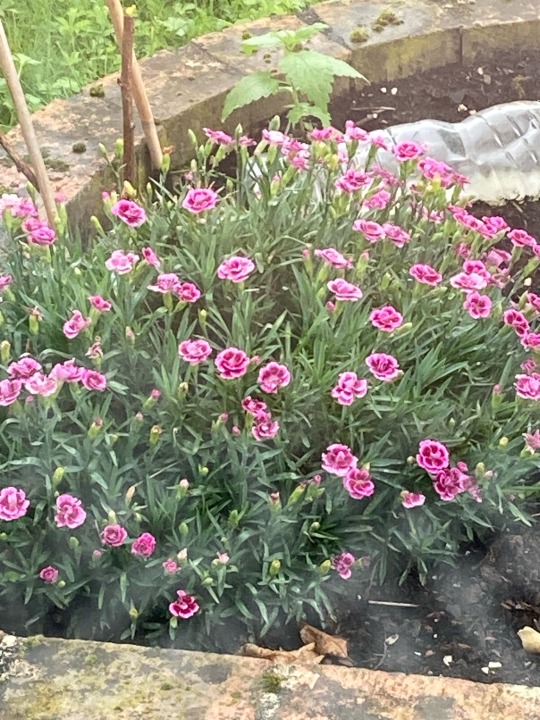
07/07/2024. Greetings from Bar-sur-Aube, yes you read that right! I was allowed home, yesterday, for one night only in an attempt to boost my morale. What a night to choose as today is the day the Tour de France goes right past my house and of course I will be watching that from an upstairs window, just to make sure I don’t get bumped, cut or burned!
The last time the Men’s Tour de France came through the town was 6 July 2017, I was there on that occasion too.
The stage finish yesterday was at Colombey-Les-Deux-Eglises, Charles de Gaulle made his home there, died and is buried along with his family in the small church cemetery. It’s a mere 15 kilometres from where I live.
A couple of songs for the music spot, how about Bicycle Race by Queen from way back in 1978. Or this one that I found by Kraftwerk, Tour de France from 1983.
So how do I come to be at home? Well the transfusions the doctors were giving me had become ineffective, this hit me like a sledgehammer! Was I ever going to return home? Was there another course of treatment? What was going to happen? Well the answers were , yes there was more treatment and the “big wig” doctors were meeting to discuss the situation. Obviously I got a little upset talking to one of my doctors and she requested a night at home to boost my morale, so here I am.
I was tanked up with transfusions before I left and of courseI started thinking it’s too soon. Will I cope? I will need some food items etc etc. Then I realised it’s only one night. I will cope and voila, I have!
Monique was desperate to see me which was understandable, however, having just arrived home she was at my door within an hour. I had just managed to eat something. She didn’t stay long by and then I was free to do some washing! I must have settled down for sleep by about 10:30 and was surprised when my first real wake up was at 6:30! That was a very good sleep.
Anie messaged to see if I had arrived. I don’t know if she will come to see me tomorrow but if not I have plenty to keep me busy (I think).
So now I am thinking about breakfast, plus, apart from the TDF I am wondering how to fill the hours until my return to the hospital. The washing is on the airer outside that is hopefully going to dry quickly.
My bag is repacked and I feel ready to face the next phase of the treatment.
I am sitting in my armchair with the shutters open to get light and sunshine into the room. The sun has some strength to it even though metro tells me it is mostly cloudy and 15c.
I try to take photos of landmarks in Paris (even just from the taxi), I saw this dome shape in the distance and took the photo as we waited at the traffic lights. Unfortunately, I have been unable to identify it!
The road sign nearby indicates Austerlitz, Place d’Italie, Notre Dame and Pitié-Salpêtriere, thé hospital where Diana, Princess of Wales was taken after the crash in the Pont de l’Alma in 1997. Google the hospital to see other famous personalities who have been treated there, including one Michael Schumacher. I did note that the one of the two men who came to do the aspiration of bone marrow from my sternum was wearing clothes not showing Sainte-Antoine hospital but Pitié-Salpetriere 😊.
Now all that is left to be done is to wish you a very happy Sunday and to say that next time we meet I imagine I will be back in my hospital room.
🚴♂️🚴♂️🚴♂️ allez, allez.
Jusqu’à la semaine prochaine.
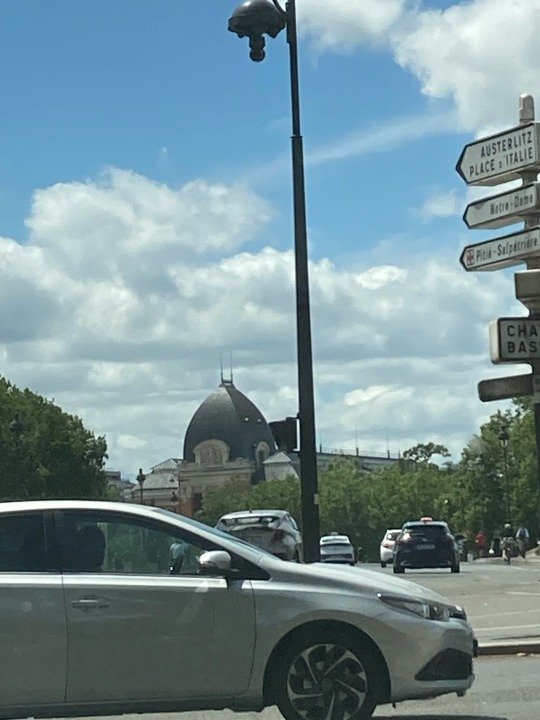
3 notes
·
View notes
Text
CONGRATS @little-orphan-ant FOR BEING THE FIRST FOLLOWER ON MY PASSION PROJECT @la-salpetriere YOU MEAN EVEYRTHING TO ME
0 notes
Text
Inspired by the history of La Salpetriere hospital for “hysterics”, The Madwomen of Paris presents a fictional account of the days of this asylum under Jean-Martin Charcot. It presents the story, of scientific discovery, but, even more so, of women used and abandoned for the purposes of others, and of a dream of escape. I find the premise of the book - the history and the science - fascinating. However, the telling of story unfortunately does not work for me.
Reviewed for NetGalley.
#book#fiction#book review#netgalley#bookreview#book blog#review#historical fiction#paris#hysteria#psychoanalysis#salpetriere
0 notes
Text
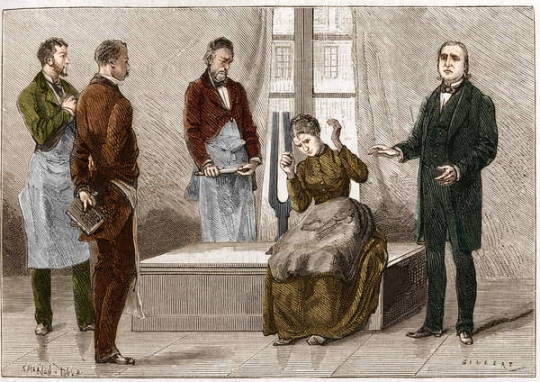
Catalepsia producida bajo la influencia del sonido (Diapason). El neurólogo francés Jean Martin Charcot (1825-1893) (a la derecha) haciendo una demostración de hipnosis en un paciente en el hospital Salpetriere. Ilustración tomada de "Nature" 1879.
1 note
·
View note
Photo

The Last Supper by Hospital de la Salpetriere - See more viral images on ViralTiger.org
0 notes
Text
Brick Club 2.4.1 “Master Gorbeau”
Playing catch up, and I had more to say about this chapter than I thought!
Most people have already pointed out how sketchy the Gorbeau house is and how it’s not a great pick on Valjean’s part. I feel like part of that is due to the nature of his (non) existence at this point in the story. Not only is he still dead when he initially rents his rooms, he is very much still in the prison mindset he reverted back to on the Orion. He’s still thinking like a prisoner, not yet like a guardian. His renting of rooms at the Gorbeau house, which is essentially a grim sort of bolthole, illustrates how close Valjean still is to slipping back into his old prison instincts. We’ll see two chapters from now how he changes, how caring for and loving Cosette helps put him back on the straight and narrow and keep him there. Which is why they cannot stay there. He is moving too far away from “ex-convict” and into “guardian” and therefore does not fit the house or its symbols.
A lot of the locations Hugo mentions in this chapter aren’t referenced in Luc Sante’s book The Other Paris (or at least aren’t deemed important enough to be listed in the index), but he does mention that La Salpetriere was both a prison and an insane asylum. He also talks about the barrieres, their history as near-ruins of Paris’ old fortification toll-gates. He says that “Various sensational murders occurred around the barrieres, with psychopaths taking advantage of the absence of potential eyewitnesses to kill by chance and at random.” The Gorbeau house is also only paces from the Barriere Saint-Jacques, where the guillotine was moved to in 1832. At this point in the story, then, the guillotine is still in Place de Greve (which is also not too terribly far away, I think, though it is across the river). But it is an indication of the darkness and sinister energy of this location that it eventually will house the guillotine.
“There, near a factory and between two garden walls, could be seen at that time an old ruined hovel...” I know I’m probably reading way too into this but this totally seems like symbolism, again, for Valjean’s circumstances so far. The two garden walls are Fantine and Cosette, the factory is his previous existence as M Madeleine, and the Gorbeau hovel is his existence now, sandwiched between. Not to mention the factory facade resembles “a barracks or a monastery” and M-sur-M was a garrisoned town, and Valjean will soon be in Petit-Picpus.
The door that is a hovel-door and the window that is a lordly-window feels so weirdly fairytale to me. It kind of makes me think of A Little Princess, and the way that even the most rundown things turn into lavishly beautiful pieces in Sara Crewe’s eyes. Like it has the potential to do that, or used to have that potential.
“On the inside of the door a brush dipped in ink had traced with a couple of strokes the number 52, and above the door the same brush had daubed the number 50, so that a newcomer would hesitate, asking “Where am I?” The top of the entrance says, Number 50; the inside, however, replies No! Number 52!”
Man, the Gorbeau House is so interesting. It is a liminal state. The entire house, everything about it, is a liminal state. As we read about it, as it stands in the novel, it exists with the potential of the guillotine; we have moved past the house by the time the guillotine moves to Place Saint-Jacques. Valjean exists in it in the state between prisoner-Valjean and guardian-Valjean, but once he has moved towards guardian-Valjean, he cannot stay there. Later, it will exist to be Marius’ transitional space between leaving home and learning Cosette’s identity. It is on the road to Bicetre. It is existing in this in-between stage of a neighborhood in ruins, falling down but not yet fallen down, being cut through or widened with new streets but not yet totally destroyed, at the edge of the suburb and the city.
So there’s no way Valjean and Cosette could have stayed there. If they did, they would have stagnated. This is a transitional space for them to learn each other and grow trusting of each other and to learn to love each other. Valjean is re-learning how to be a person after being in prison (we saw the start of it back at the Thenardiers’ as he lost his timidity), and Cosette is learning how to be a regular little girl after leaving the abuse of the Thenardiers. They are in similar spaces here, and this is a place for them to figure things out. But they can’t stay. It doesn’t make sense.
(Which makes me wonder how long the Thenardiers had been in the Gorbeau house when Marius moved in. How long were they stagnated in this transitory space. And did Marius paying their rent pull them back into stagnation?)
#les miserables#les miserables meta#brickclub#lm 2.4.1#les mis#les mis meta#i'm too lazy to write my French words with their required accents i'm sorry
22 notes
·
View notes
Text
Blanche Wittman and PNES (Psychogenic Non-Epileptic Seizures)
Blanche Wittman, famed La Salpêtrière hysteric is the pinnacle of what the modern-day public thinks of when they imagine "female hysteria" that being young women institutionalized and used as entertainment. In fact, most of our modern understanding of what hysteria was comes from Jean-Martin Charcot's work on La Salpêtrière's hysterics, one of the most notable examples being Blanche Whittman, forever immortalized in photographs and of course the famous André Brouillet painting "Une leçon clinique à la Salpêtrière"


Her dramatized and public portrayal of hysteria has led to an increase in awareness of neurological and psychiatric conditions primarily effecting women, PNES (Psychogenic Non-Epileptic Seizures) which falls somewhere between psychiatric and neurological being one of these conditions, which seems a likely diagnosis for her if Blanche were to visit a modern neurology clinic.
What is PNES? PNES (Psychogenic Non-Epileptic Seizures) are seizure episodes that highly resemble that of an epileptic seizure, though no brain activity resembling epilepsy is present. These seizures have a psychological basis, instead of a neurological one, though neurological imaging may be used in diagnosis before treatment is turned over to a psychologist or psychiatrist.
Blanche Wittman's symptoms present in her public case information across volumes of "Iconographie photographique de la Salpêtrière" line up very well with the current diagnostic criteria of PNES.
When Blanche was first admitted into La Salpêtrière in 1877, she was 18 years old, 1.62 meters tall (considered above average in this period) and weighing in at 70kg. Being raised in a troublesome and poor family, she was never taught to read and her intelligence was labeled as being below average by the hospital.
As stated before, Blanche was raised in a troublesome family, having nine siblings, including five who died in childhood from epilepsy and convulsions. Her father was prone to "fits of rage" and physically abused the young Blanche in many instances, and her mother died when Blanche was young, though the exact age varies from source to source.
She began a sexual relationship with her employer, a furrier, by force at the age of 15. She then admitted herself to a hospital (unclear exactly where) to escape the abuse eight months after it began. A while later she reported another sexual relationship with a boy called Alphonse. It seems to be unclear whether this relationship was consented to by Blanche, or another example of sexual abuse against her.
Abuse, especially sexual is an extremely common background in those with PNES. A diagnosis of PTSD or C-PTSD with PNES is quite common. It seems extremely likely that her abuse she went through played a role in these "hysterical attacks"
After some time taking refuge at a convent (Blanche seems to have been a devout Catholic, wearing a scapular and collecting various pieces of Christian iconography) she began working as a servant at La Salpêtrière, thinking this would make it easier for her to be eventually admitted into the hospital after they see her attacks.
Blanche eventually succeeded in her goal of being admitted to La Salpêtrière in 1877, at the age of 18. Her time there coincided with the peak of Jean-Martin Charcot's studies on hysteria, and she quickly became one of his star patients. Charcot’s research focused on hysteria as a neurological disorder, and his methods of public "demonstrations" of hysterical patients, including Blanche, led to increased attention to the condition. These public displays, often featuring dramatic reenactments of symptoms, cast a long shadow over how hysteria and by extension, women’s health was perceived for decades.
Blanche’s displays of hysteria to the public were not only attended by a medical crowd, but was also popular among a non-medical crowd, including that of actors, who would come to study Blanche’s intense displays of emotion under hypnosis.
Hypnosis was frequently used on Blanche during these displays, often to achieve the state of somnambulism, or extreme suggestibility, where the hypnotist could make her to believe just about anything they so desired, the effects sometimes even lasting long after the trance.
While the primary purpose of these displays was supposedly to educate on hysteria, they often came off as more entertaining stage hypnosis than anything. Some of this was mindless entertainment, though some was clearly intended to use Blanche’s fear and distress for laughs, whether to the audience or the hospital staff themselves, often young male medical students, finding it hilarious to sexualize and upset her.
During her intense states of somnambulism, she was often made to hallucinate snakes and rats at her feet. She would hike up her skirt and squeal, prompting voyeuristic laughs from the audience.
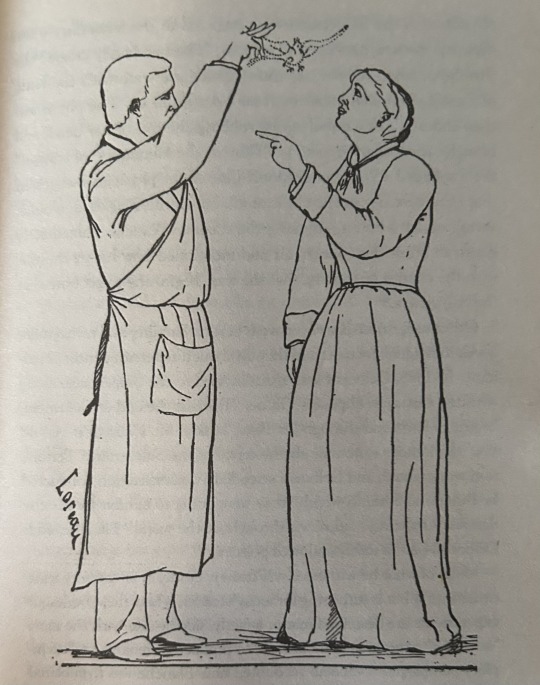

Unlike the many “wandering womb” theories we often associate with hysteria today, Charcot was among the first who believed hysteria had a neurological origin, attributing symptoms like convulsions, paralysis, and loss of consciousness to issues within the brain. This makes sense as Charcot was most certainly extremely knowledgeable about neuroscience. In fact, he was the first to identify and name multiple sclerosis as it’s own distinct condition, pioneered much amyotrophic lateral sclerosis research (the disease even being known as Charcot’s disease in parts of the world) and is associated with at least 15 different diseases named after him. For this reason, it only makes sense that a condition with invisible physical pathology must be caused by nervous system abnormalities, this being even more apparent when remembering this was a time before complex brain imaging and EEG technology was in use, it was nearly impossible to know whether something was psychological or neurological, and Charcot believed the latter.
However, many of these symptoms would align more closely with what we now understand as psychogenic non-epileptic seizures (PNES), a condition rooted in psychological trauma rather than physical abnormalities in the brain. Today, PNES is understood as a dissociative disorder, often linked to past trauma, which manifests in seizure episodes without the electrical disruptions seen in epilepsy.
Before her time institutionalized, Blanche's life was full of trauma and abuse, often seen in PNES patients. Not only that but Blanche also demonstrated a good example of "the teddy bear sign" a frequent pattern in PNES patients and an aid in diagnosis. A majority of PNES patients show up to EEG monitoring appointments with a comfort item, most often a stuffed animal. While we don't know exactly what Blanche would have done in the modern day, we do know she was an avid collector of stuffed animals and various little trinkets. This was common behavior among hysterics, suggesting what in the modern day we would call PNES was common among hysterics.
The "hysterical attacks" that made her a spectacle were, in all likelihood, trauma responses—demonstrations of a mind and body deeply affected by abuse. While these days are long gone, it's important to see just how much this outdated understanding of the brain both holds back and progresses our knowledge of the connection between body and brain.
5 notes
·
View notes
Photo

Régnard, photograph of Augustine (“Attitudes passionnelles: Ecstasy”), Iconographie, vol. II.
Published in 2003
Invention of Hysteria: Charcot and the Photographic Iconography of the Salpêtrière, Georges Didi-Huberman, Alisa Hartz
In this classic of French cultural studies, Georges Didi-Huberman traces the intimate and reciprocal relationship between the disciplines of psychiatry and photography in the late nineteenth century. Focusing on the immense photographic output of the Salpetriere hospital, the notorious Parisian asylum for insane and incurable women, Didi-Huberman shows the crucial role played by photography in the invention of the category of hysteria. Under the direction of the medical teacher and clinician Jean-Martin Charcot, the inmates of Salpetriere identified as hysterics were methodically photographed, providing skeptical colleagues with visual proof of hysteria's specific form. These images, many of which appear in this book, provided the materials for the multivolume album Iconographie photographique de la Salpetriere. As Didi-Huberman shows, these photographs were far from simply objective documentation. The subjects were required to portray their hysterical "type" -- they performed their own hysteria. Bribed by the special status they enjoyed in the purgatory of experimentation and threatened with transfer back to the inferno of the incurables, the women patiently posed for the photographs and submitted to presentations of hysterical attacks before the crowds that gathered for Charcot's "Tuesday Lectures." Charcot did not stop at voyeuristic observation. Through techniques such as hypnosis, electroshock therapy, and genital manipulation, he instigated the hysterical symptoms in his patients, eventually giving rise to hatred and resistance on their part. Didi-Huberman follows this path from complicity to antipathy in one of Charcot's favorite "cases," that of Augustine, whose image crops up again and again in the Iconographie. Augustine's virtuosic performance of hysteria ultimately became one of self-sacrifice, seen in pictures of ecstasy, crucifixion, and silent cries.
Georges Didi-Huberman, Alisa Hartz
+
#Paul Regnard#Photograph of Augustine#Invention of Hysteria: Charcot and the Photographic Iconography of the Salpêtrière#Psychology#Hysteria#Hôpital de la Salpêtrière Paris
32 notes
·
View notes
Photo

The Last Supper by Hospital de la Salpetriere
Source: Reddit by maestroenglish
#the last supper#jesus christ#covid_19#covid-19#pandemic#doctors#god#almighty#leonardo da vinci#painting
14 notes
·
View notes
Video
tumblr
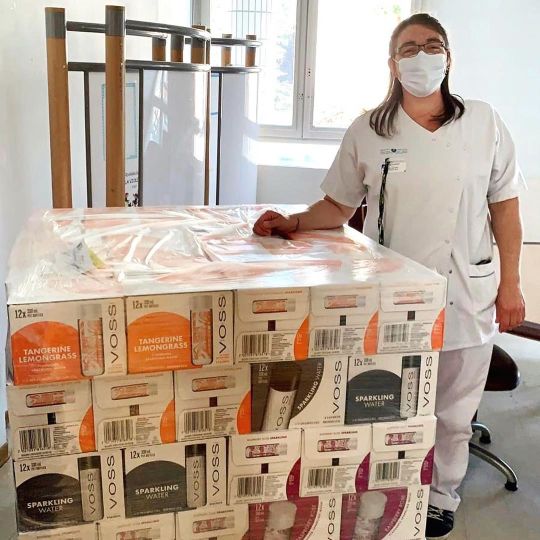

guillaume_cizeron: Hey guys, I have some exciting news to share. @GabriellaPapadakis myself & @vossworld came together in making a donation of 1,600+ bottles of water to Hopital La Pitie Salpetriere to hydrate the doctors & nurses during these difficult times. Thank you @vossfrance for this generous gesture for our doctors and nurses. Swipe for some of my favorite moments from the delivery this week!
(14.05.2020) (2/2)
3 notes
·
View notes
Text
advertising my two main sideblogs:
fucking insane poetry and lore drops: @granhairdopoetry
my nerdy interest other than les mis (zero followers on here i love this blog give it love): @la-salpetriere
0 notes
Link
2 notes
·
View notes
Text
1er Mai à la Pitié-Salpêtrière: les mensonges du pouvoir http://www.mediapart.fr/journal/france/020519/1er-mai-la-pitie-salpetriere-les-mensonges-du-pouvoir?utm_source=global&utm_medium=social&utm_campaign=SharingApp&xtor=CS3-5
4 notes
·
View notes